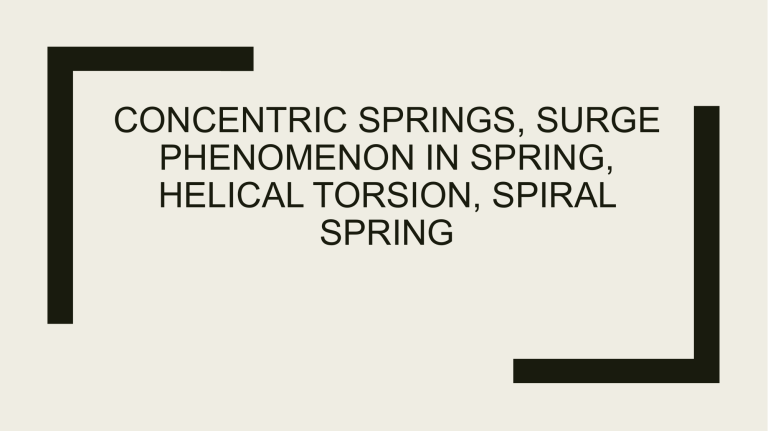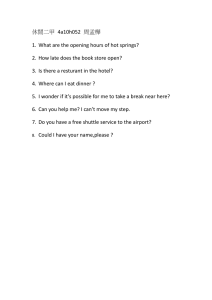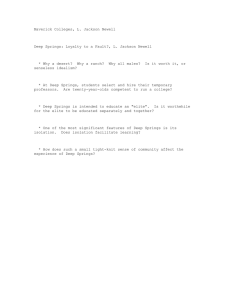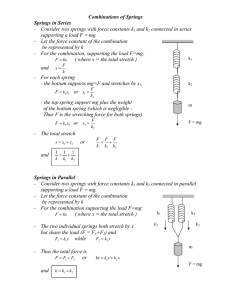concentricspringssurgephenomenoninspringhelicaltorsionspiralspring-190224084541
advertisement

CONCENTRIC SPRINGS, SURGE PHENOMENON IN SPRING, HELICAL TORSION, SPIRAL SPRING Introduction (Springs): ■ Definition: Springs are elastic bodies (generally metal) that can be twisted pulled or stretched by some force. They can be return to their original shape when the force is released. ■ Concept: There is not much physics behind it when the spring is stretched or squashed it creates a force in the opposite direction because the spring tries to get back to its original position. Concentric Springs ■ When one spring is placed inside the other spring, the arrangement is called Concentric spring or Composite spring. ■ The concentric springs are basically springs in parallel. The coils of two springs are wound in opposite direction to eliminate any possibility of interference or binding. ■ Purpose of using Concentric spring: – To obtain the greater force. – To change the stiffness of the spring system at a certain deflection. – To assure the working of a mechanism in the event of failure of one of the springs. Concentric Springs ■ Types of Concentric Springs : – Concentric Springs of equal lengths – Concentric Springs of unequal lengths ■ Concentric Springs of equal lengths : – Concentric Springs of equal lengths The Concentric Springs of the equal free lengths are used in automobile clutches & valve spring of heavy duty engines ■ Concentric Springs of unequal lengths : – The Concentric Springs of the different free lengths, the shorter spring begins to act only after the longer spring is compressed by a certain amount. These springs re used in governors of variable speed engines to take the care of the variable centrifugal force. Concentric Springs of unequal lengths Surge Phenomenon in Spring When one end of a helical spring is resting on a rigid support and the other end is loaded suddenly, then all the coils of the spring will not suddenly deflect equally, because some time is required for the propagation of stress along the spring wire. A little consideration will show that in the beginning, the end coils of the spring in contact with the applied load takes up whole of the deflection and then it transmits a large part of its deflection to the adjacent coils. In this way, a wave of compression propagates through the coils to the supported end from where it is reflected back to the deflected end. This wave of compression travels along the spring indefinitely. If the applied load is of fluctuating type as in the case of valve spring in internal combustion engines and if the time interval between the load applications is equal to the time required for the wave to travel from one end to the other end, then resonance will occur. This results in very large deflections of the coils and correspondingly very high stresses. Under these conditions, it is just possible that the spring may fail. This phenomenon is called surge. Surge Phenomenon in Spring ■ What is surging : – When a coil spring absorbs shock, the coil wire undergoes torsion, which is transmitted as a shock wave. This shockwave is called a surge wave. – The amount of time (T) in which this surge wave moves along the spring wire and travels back is called surge time. The surge time and speed can be calculated using the following formula: Surge time T 2 n D/a D : Mean diameter of coil n : Number of active turns a : Surge speed c : Spring index Surge speed a – 1 c gG 1 2 1 1 / 2c 2 G : Shear modulus of spring material : Unit weight of Spring material g : Gravitational acceleration When a coil spring is subject to forced oscillation, the resonance phenomenon surging occurs if the cycle corresponds to the surge time T or becomes the half or one third of the surge time T. Surge Phenomenon in Spring ■ The surge in springs may be eliminated by using the following methods : – The spring is designed in such a way that the natural frequency of the spring is 15 to 20 times the frequency of excitation of the external force. This prevents the resonance condition to occur. – The spring is provided with friction dampers on central coils. This prevents propagation of surge wave. – A spring made of stranded wire reduces the surge. In this case, the wire of the spring is made of three strands. The direction of winding of strands is opposite to the direction of winding of the coils while forming the spring. In case of compression of the coils, the spring tends to wind the individual wires closer together, which introduces friction. This frictional damping reduces the possibility of surge. Helical Torsion Springs ■ A torsion spring is a spring that works by torsion or twisting. ■ It Can be loaded in torsion instead of compression or tension ■ Ends are extended tangentially to provide lever arms on which to apply moment load ■ Ends come in variety of shapes to suit application ■ Coils are close wound like extension springs (but do not have any initial tension), but in few cases are wound with spacing like compression spring (this will avoid friction between coils) ■ Dynamic loading should be repeated or fluctuating with stress ratio R ≥ 0 ■ Applied moment should never be reversed in service Helical Torsion Springs ■ Normal stresses are produced in torsion springs ■ Load should be defined at angle α between tangent ends in loaded position rather than at deflection from free position ■ Rectangular wire is more efficient (because load is in bending) in terms of stiffness per unit volume (larger I for same dimension) ■ However, most helical torsion springs are made from round wire because of its lower cost and larger variety of available sizes and materials ■ Torsion springs are used in door hinges, rat traps, automobile starters, finger exercisers, garage doors and etc. Helical Torsion Springs ■ Number of Coils in Torsion Springs – For straight ends, the contribution to equation can be expressed as an equivalent number of coils Ne: – Active coils Na : L1 L2 Ne 3D & N a Nb Ne – Where Nb is number of coils in spring body ■ Deflection – Angular deflections of coil-end is normally expressed in radians, but is often converted to revolutions. Revolutions will be used. M applied moment θ rev 1 1 MLw θ rad 2 2 EI Lw length of wire E Young’ s modulus I moment of inertia Spiral Spring ■ A spring consisting of a wire coiled usually in a flat spiral or in a helix. ■ Spiral springs are used as balancing springs for smaller angles of rotation. The energy stored is used as a counterbalance or self-aligning torque. The increase in the spring curve is almost linear. ■ Spiral torsion springs are used in brush motors and in certain applications where a short rotation is required. Industries that use spiral torsion springs include: – Electric Motors – Industrial Tools – Automotive / Transportation – Medical Devices / Healthcare



